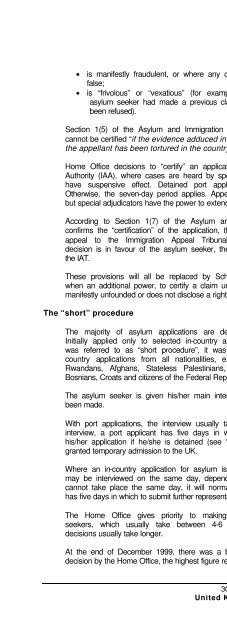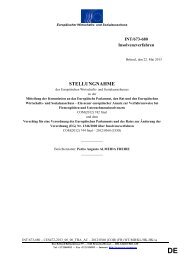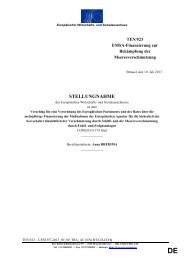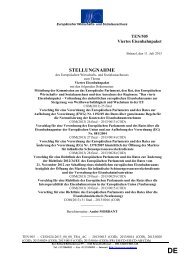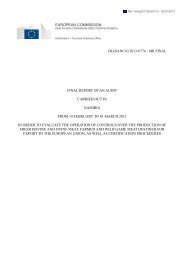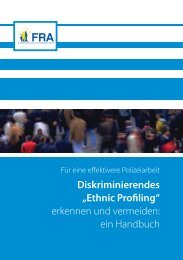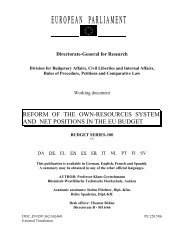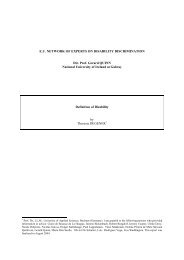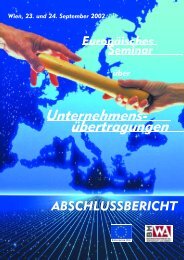legal and social conditions for asylum seekers and refugees in ...
legal and social conditions for asylum seekers and refugees in ...
legal and social conditions for asylum seekers and refugees in ...
Create successful ePaper yourself
Turn your PDF publications into a flip-book with our unique Google optimized e-Paper software.
• is manifestly fraudulent, or where any of the evidence adduced <strong>in</strong> its support is manifestly<br />
false;<br />
• is “frivolous” or “vexatious” (<strong>for</strong> example, a claim could be considered vexatious if an<br />
<strong>asylum</strong> seeker had made a previous claim <strong>for</strong> <strong>asylum</strong> based on the same facts, which had<br />
been refused).<br />
Section 1(5) of the Asylum <strong>and</strong> Immigration Act 1996 provides that a substantive <strong>asylum</strong> claim<br />
cannot be certified “if the evidence adduced <strong>in</strong> its support establishes a reasonable likelihood that<br />
the appellant has been tortured <strong>in</strong> the country or territory to which he is to be sent”.<br />
Home Office decisions to “certify” an application may be appealed to the Immigration Appellate<br />
Authority (IAA), where cases are heard by special adjudicators sitt<strong>in</strong>g on their own. Such appeals<br />
have suspensive effect. Deta<strong>in</strong>ed port applicants must lodge their appeal with<strong>in</strong> two days.<br />
Otherwise, the seven-day period applies. Appeals must be decided with<strong>in</strong> ten days of submission,<br />
but special adjudicators have the power to extend this time limit.<br />
Accord<strong>in</strong>g to Section 1(7) of the Asylum <strong>and</strong> Immigration Act 1996, if the special adjudicator<br />
confirms the “certification” of the application, the <strong>asylum</strong> seeker may no longer apply <strong>for</strong> leave to<br />
appeal to the Immigration Appeal Tribunal (IAT). However, when the special adjudicator's<br />
decision is <strong>in</strong> favour of the <strong>asylum</strong> seeker, the Home Office may still apply <strong>for</strong> leave to appeal to<br />
the IAT.<br />
These provisions will all be replaced by Schedule 4 to the immigration <strong>and</strong> Asylum Act 1999,<br />
when an additional power, to certify a claim under Article 3 of the ECHR on the grounds that it is<br />
manifestly unfounded or does not disclose a right under that Convention, will also apply.<br />
The “short” procedure<br />
The majority of <strong>asylum</strong> applications are dealt with under the so-called “st<strong>and</strong>ard procedure”.<br />
Initially applied only to selected <strong>in</strong>-country <strong>asylum</strong> applications from seven nationalities, when it<br />
was referred to as “short procedure”, it was subsequently extended to cover both port <strong>and</strong> <strong>in</strong>country<br />
applications from all nationalities, except Iraqis, Iranians, Libyans, Somalis, Liberians,<br />
Rw<strong>and</strong>ans, Afghans, Stateless Palest<strong>in</strong>ians, nationals of the Gulf States (except Kuwaitis),<br />
Bosnians, Croats <strong>and</strong> citizens of the Federal Republic of Yugoslavia.<br />
The <strong>asylum</strong> seeker is given his/her ma<strong>in</strong> <strong>in</strong>terview as soon as possible after the application has<br />
been made.<br />
With port applications, the <strong>in</strong>terview usually takes place with<strong>in</strong> 24 hours of arrival. Follow<strong>in</strong>g the<br />
<strong>in</strong>terview, a port applicant has five days <strong>in</strong> which to submit further representations <strong>in</strong> support of<br />
his/her application if he/she is deta<strong>in</strong>ed (see “Detention” below), <strong>and</strong> 28 days if he/she has been<br />
granted temporary admission to the UK.<br />
Where an <strong>in</strong>-country application <strong>for</strong> <strong>asylum</strong> is made <strong>in</strong> person at the Home Office, the applicant<br />
may be <strong>in</strong>terviewed on the same day, depend<strong>in</strong>g on the availability of <strong>in</strong>terpreters. If the <strong>in</strong>terview<br />
cannot take place the same day, it will normally be held with<strong>in</strong> the next 3-4 weeks. The applicant<br />
has five days <strong>in</strong> which to submit further representations follow<strong>in</strong>g the <strong>in</strong>terview.<br />
The Home Office gives priority to mak<strong>in</strong>g decisions on applications from deta<strong>in</strong>ed <strong>asylum</strong><br />
<strong>seekers</strong>, which usually take between 4-6 weeks, <strong>and</strong> from unaccompanied children. Other<br />
decisions usually take longer.<br />
At the end of December 1999, there was a backlog of over 102,000 <strong>asylum</strong> applications await<strong>in</strong>g<br />
decision by the Home Office, the highest figure recorded <strong>in</strong> the UK.<br />
308<br />
United K<strong>in</strong>gdom


